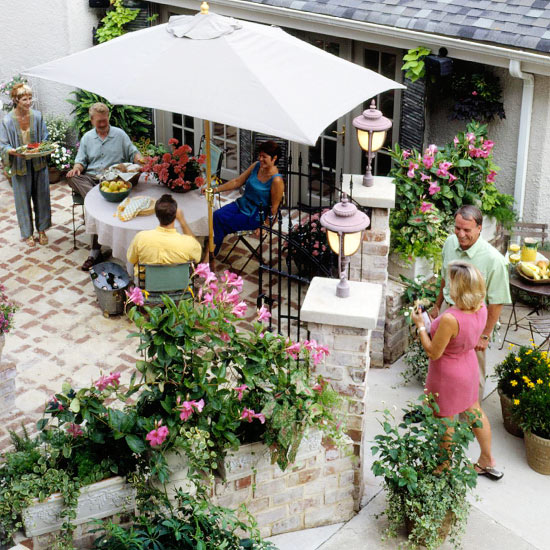






Step 1. Determine your needs. Make a list of all the ways you want to use the patio. This list might include an area for reading and relaxing, for an intimate dinner for four, or for a casual gathering of 20 friends. It may be all of the above and more.
As you enumerate the various uses for the patio, indicate which of them are most important to you. Many homeowners have an occasional need for the patio to accommodate large groups, but the vast majority of the time need to have enough room for only up to four people. One way to have a larger patio that still feels intimate is to use potted plants to frame part of the space. They can be moved when you need the extra room.
23 ways to design the perfect outdoor space.
Step 2. Determine the type and amount of furniture required. Once you know how many people you need to accommodate, you can select the furniture. Typically this includes tables, chairs, and benches. Note anything else you want in the space, such as a grill or a drink cart.
If you already have or know the type of furniture you will use, measure all the pieces so you can plan the patio exactly. If you don't know what furniture you will have, you can use the general guidelines offered below.

Step 3. Figure the amount of space you need. The size of your patio is a personal decision, but there are some guidelines that may help you determine the right size for your needs.
If all you want is space for two people to sit with a small table in between, you can get by with a patio as small as 10 feet by 10 feet. Keep in mind that a patio this small may look out of place if it is attached to the house.
For an attached patio, start with 10 feet by 20 feet as a minimum. That will provide enough room for four chairs and a small dining table.
As you map out the exact dimensions of the patio, plan for about 3 feet by 3 feet per chair. This allows room for the chair and a comfort zone around it. The average garden bench requires about 6 feet by 3 feet.
Table sizes vary, but a standard bridge table is 3 feet by 3 feet. This may be too small for dining; the recommended space for a dining table for four people is 4 feet by 4 feet.
Sketch the general shape, size, and location of the patio onto grid paper, with each grid equaling 6 inches. Then cut out pieces of paper to scale to represent chairs, tables, and benches. Move them around on the sketch to make sure you've allowed enough space. Be sure to leave room for people to walk around the furniture.
 An intimate gathering is most
enjoyable in a smaller space.
An intimate gathering is most
enjoyable in a smaller space.
Step 3. Figure the amount of space you need. The size of your patio is a personal decision, but there are some guidelines that may help you determine the right size for your needs.
If all you want is space for two people to sit with a small table in between, you can get by with a patio as small as 10 feet by 10 feet. Keep in mind that a patio this small may look out of place if it is attached to the house.
For an attached patio, start with 10 feet by 20 feet as a minimum. That will provide enough room for four chairs and a small dining table.
As you map out the exact dimensions of the patio, plan for about 3 feet by 3 feet per chair. This allows room for the chair and a comfort zone around it. The average garden bench requires about 6 feet by 3 feet.
Table sizes vary, but a standard bridge table is 3 feet by 3 feet. This may be too small for dining; the recommended space for a dining table for four people is 4 feet by 4 feet.
Sketch the general shape, size, and location of the patio onto grid paper, with each grid equaling 6 inches. Then cut out pieces of paper to scale to represent chairs, tables, and benches. Move them around on the sketch to make sure you've allowed enough space. Be sure to leave room for people to walk around the furniture.
A Colorful Patio Garden Plan
Copyright © www.100flowers.win Botanic Garden All Rights Reserved